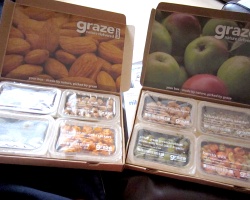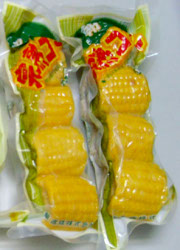 Ok, this is a bit of a rant dressed up as a Recycle This style question – it’s a genuine question but I feel the need to rant too! ;)
Ok, this is a bit of a rant dressed up as a Recycle This style question – it’s a genuine question but I feel the need to rant too! ;)
So many people in my (geeky) world are going nuts for these at the moment and it makes me want to cry — all the packaging, all the waste.
Graze boxes are designed to lure people away from vending machines and sugary snacks at work and get them eating more natural, healthier alternative instead. For £3.29 a pop, you get a box of snacks delivered to your desk instead – four different snacks (such as dried fruit, nuts, seeds, olives or crackers) inside little film-covered plastic tubs and encased in a cardboard box. The idea is to have them delivered regularly – several times a week – so you’re never tempted by that Mars bar or long-life vacuum-sealed muffin.
Graze’s claim to have thought carefully about the packaging – the cardboard is from a sustainable forest, is designed to be use as little material as possible & can easily be recycled again, and Mrs G from My Zero Waste asked about the plastic of the pots and it’s apparently PETE (resin code 1) which is widely recyclable where plastics are recycled.
Yes, it’s good news that the plastic is widely recyclable plastic – but getting a pack of it delivered to your door is hardly reducing waste (the first and most important of the 3Rs) and it’s not obviously reusable either. Where plastics aren’t kerbside recyclable, that PETE is likely to end up in the bin – and even the cardboard might too since offices don’t always have full recycling facilities.
(I’ll try to remain on topic with my rant here and not get into: i. how much energy is wasted transporting these light but bulky items around the country; ii. how much more expensive they are than buying the items directly; iii. how it’s easier to buy something than make a genuine lifestyle change.)
Anyway, I think you probably get the gist of my annoyance so let’s get constructive instead: the packaging can be recycled where facilities are available, any reuse suggestions though?
And what about reducing people’s use of them? Do you have any tips or suggestions how people could have the same healthy snacking experience without so much packaging?
(PS. sorry for the ranting ;) )
(CCA Photo by philcampbell)
 Hey guys, sorry I haven’t got time to write a full Recycle This post today – but can I point you to the latest article on my new blog The Really Good Life?
Hey guys, sorry I haven’t got time to write a full Recycle This post today – but can I point you to the latest article on my new blog The Really Good Life?


 At one point during
At one point during  Ok, this is a bit of a rant dressed up as a Recycle This style question – it’s a genuine question but I feel the need to rant too! ;)
Ok, this is a bit of a rant dressed up as a Recycle This style question – it’s a genuine question but I feel the need to rant too! ;) Yesterday, over on my new growing/cooking/making/frugal blog
Yesterday, over on my new growing/cooking/making/frugal blog 














